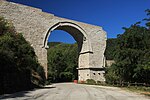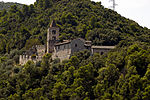Santa Maria Impensole, Narni
12th-century Roman Catholic church buildings in ItalyChurches in NarniItaly Roman Catholic church stubsRoman Catholic churches in UmbriaRomanesque architecture in Umbria

Santa Maria Impensole is a Romanesque style church in the center of Narni, Province of Terni, Italy. The church name likely derives from the term in pisilis which refers to either overhanging or held in suspension.
Excerpt from the Wikipedia article Santa Maria Impensole, Narni (License: CC BY-SA 3.0, Authors, Images).Santa Maria Impensole, Narni
Vicolo della vite,
Geographical coordinates (GPS) Address External links Nearby Places Show on map
Geographical coordinates (GPS)
| Latitude | Longitude |
|---|---|
| N 42.5199874 ° | E 12.5152619 ° |
Address
Chiesa di Santa Maria Impensole
Vicolo della vite
05035
Umbria, Italy
Open on Google Maps











